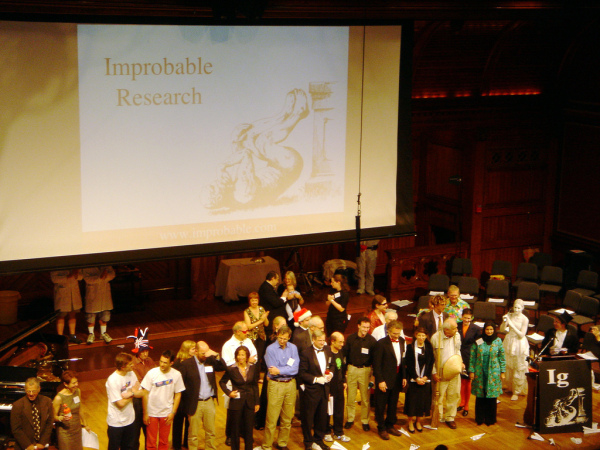The Ig Nobel Prizes are a parody of the Nobel Prizes - awarded each year by the scientific humor magazine Annals of Improbable Research. They began in 1991 as a way to draw attention to projects "that cannot, or should not, be reproduced." It is a humorous event each October on Harvard's campus and the awards are handed out by genuine Nobel Laureates.
I went through the list of past winners and culled out the food related awards. If I put my mind to it, maybe I could win an Ig Nobel Prize too:
2008
NUTRITION PRIZE. Massimiliano Zampini of the University of Trento, Italy and Charles Spence of Oxford University, UK, for electronically modifying the sound of a potato chip to make the person chewing the chip believe it to be crisper and fresher than it really is.
CHEMISTRY PRIZE. Sharee A. Umpierre of the University of Puerto Rico, Joseph A. Hill of The Fertility Centers of New England (USA), Deborah J. Anderson of Boston University School of Medicine and Harvard Medical School (USA), for discovering that Coca-Cola is an effective spermicide, and to Chuang-Ye Hong of Taipei Medical University (Taiwan), C.C. Shieh, P. Wu, and B.N. Chiang (all of Taiwan) for discovering that it is not.
2007
CHEMISTRY: Mayu Yamamoto of the International Medical Center of Japan, for developing a way to extract vanillin -- vanilla fragrance and flavoring -- from cow dung.
PRESS NOTE: Toscanini's Ice Cream, the finest ice cream shop in Cambridge, Massachusetts, created a new ice cream flavor in honor of Mayu Yamamoto, and introduced it at the Ig Nobel ceremony. The flavor is called "Yum-a-Moto Vanilla Twist."
NUTRITION: Brian Wansink of Cornell University (from our article Is The 'Joy of Cooking' Fattening Us Up?), for exploring the seemingly boundless appetites of human beings, by feeding them with a self-refilling, bottomless bowl of soup.
2006
NUTRITION: Wasmia Al-Houty of Kuwait University and Faten Al-Mussalam of the Kuwait Environment Public Authority, for showing that dung beetles are finicky eaters.
PHYSICS: Basile Audoly and Sebastien Neukirch of the Université Pierre et Marie Curie, in Paris, for their insights into why, when you bend dry spaghetti, it often breaks into more than two pieces.
CHEMISTRY: Antonio Mulet, José Javier Benedito and José Bon of the University of Valencia, Spain, and Carmen Rosselló of the University of Illes Balears, in Palma de Mallorca, Spain, for their study "Ultrasonic Velocity in Cheddar Cheese as Affected by Temperature."
BIOLOGY: Bart Knols and Ruurd de Jong of Wageningen Agricultural University for showing that the female malaria mosquito Anopheles gambiae is attracted equally to the smell of limburger cheese and to the smell of human feet.
2005
CHEMISTRY: Edward Cussler of the University of Minnesota and Brian Gettelfinger of the University of Minnesota and the University of Wisconsin, for conducting a careful experiment to settle the longstanding scientific question: can people swim faster in syrup or in water?
NUTRITION: Dr. Yoshiro Nakamats of Tokyo, Japan, for photographing and retrospectively analyzing every meal he has consumed during a period of 34 years (and counting).
2004
PUBLIC HEALTH
Jillian Clarke of the Chicago High School for Agricultural Sciences, and then Howard University, for investigating the scientific validity of the Five-Second Rule about whether it's safe to eat food that's been dropped on the floor.
2003
PHYSICS
Jack Harvey, John Culvenor, Warren Payne, Steve Cowley, Michael Lawrance, David Stuart, and Robyn Williams of Australia, for their irresistible report "An Analysis of the Forces Required to Drag Sheep over Various Surfaces."
BIOLOGY
C.W. Moeliker, of Natuurhistorisch Museum Rotterdam, the Netherlands, for documenting the first scientifically recorded case of homosexual necrophilia in the mallard duck.
2002
PHYSICS
Arnd Leike of the University of Munich, for demonstrating that beer froth obeys the mathematical Law of Exponential Decay.
2001
MEDICINE
Peter Barss of McGill University, for his impactful medical report "Injuries Due to Falling Coconuts."
BIOLOGY
Buck Weimer of Pueblo, Colorado for inventing Under-Ease, airtight underwear with a replaceable charcoal filter that removes bad-smelling gases before they escape.
2000
LITERATURE
Jasmuheen (formerly known as Ellen Greve) of Australia, first lady of Breatharianism, for her book "Living on Light," which explains that although some people do eat food, they don't ever really need to.
1999
SOCIOLOGY
Steve Penfold, of York University in Toronto, for doing his PhD thesis on the sociology of Canadian donut shops.
PHYSICS
Dr. Len Fisher of Bath, England and Sydney, Australia for calculating the optimal way to dunk a biscuit.
...and...
Professor Jean-Marc Vanden-Broeck of the University of East Anglia, England, and Belgium, for calculating how to make a teapot spout that does not drip.
LITERATURE
The British Standards Institution for its six-page specification (BS-6008) of the proper way to make a cup of tea.
BIOLOGY
Dr. Paul Bosland, director of The Chile Pepper Institute, New Mexico State University, Las Cruces, New Mexico, for breeding a spiceless jalapeno chile pepper.
1998
BIOLOGY
Peter Fong of Gettysburg College, Gettysburg, Pennsylvania, for contributing to the happiness of clams by giving them Prozac.
1997
BIOLOGY
T. Yagyu and his colleagues from the University Hospital of Zurich, Switzerland, from Kansai Medical University in Osaka, Japan, and from Neuroscience Technology Research in Prague, Czech Republic, for measuring people's brainwave patterns while they chewed different flavors of gum.
METEOROLOGY
Bernard Vonnegut of the State University of Albany, for his revealing report, "Chicken Plucking as Measure of Tornado Wind Speed."
1996
BIOLOGY
Anders Barheim and Hogne Sandvik of the University of Bergen, Norway, for their tasty and tasteful report, "Effect of Ale, Garlic, and Soured Cream on the Appetite of Leeches."
PHYSICS
Robert Matthews of Aston University, England, for his studies of Murphy's Law, and especially for demonstrating that toast often falls on the buttered side.
CHEMISTRY
George Goble of Purdue University, for his blistering world record time for igniting a barbeque grill-three seconds, using charcoal and liquid oxygen.
1995
NUTRITION
John Martinez of J. Martinez & Company in Atlanta, Georgia, for Luak Coffee, the world's most expensive coffee, which is made from coffee beans ingested and excreted by the luak (aka, the palm civet), a bobcat-like animal native to Indonesia.
PHYSICS
D.M.R. Georget, R. Parker, and A.C. Smith, of the Institute of Food Research, Norwich, England, for their rigorous analysis of soggy breakfast cereal, published in the report entitled 'A Study of the Effects of Water Content on the Compaction Behaviour of Breakfast Cereal Flakes."
1993
CONSUMER ENGINEERING
Ron Popeil, incessant inventor and perpetual pitchman of late night television, for redefining the industrial revolution with such devices as the Veg-O-Matic, the Pocket Fisherman, Mr. Microphone, and the Inside-the-Shell Egg Scrambler.
PEACE
The Pepsi-Cola Company of the Phillipines, suppliers of sugary hopes and dreams, for sponsoring a contest to create a millionaire, and then announcing the wrong winning number, thereby inciting and uniting 800,000 riotously expectant winners, and bringing many warring factions together for the first time in their nation's history.
PHYSICS
Louis Kervran of France, ardent admirer of alchemy, for his conclusion that the calcium in chickens' eggshells is created by a process of cold fusion.
1992
CHEMISTRY
Ivette Bassa, constructor of colorfulcolloids, for her role in the crowning achievement of twentieth century chemistry, the synthesis of bright blue Jell-O.
NUTRITION
The utilizers of Spam, courageous consumers of canned comestib les, for 54 years of undiscriminating digestion.
1991
MEDICINE
Alan Kligerman, deviser of digestive deliverance, vanquisher of vapor, and inventor of Beano, for his pioneering work with anti- gas liquids that prevent bloat, gassiness, discomfort and
embarassment.

